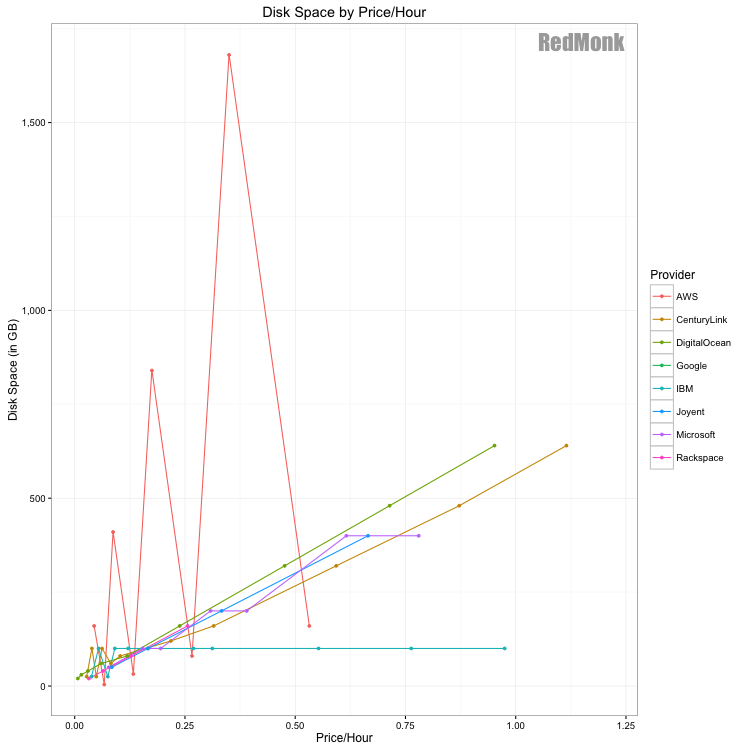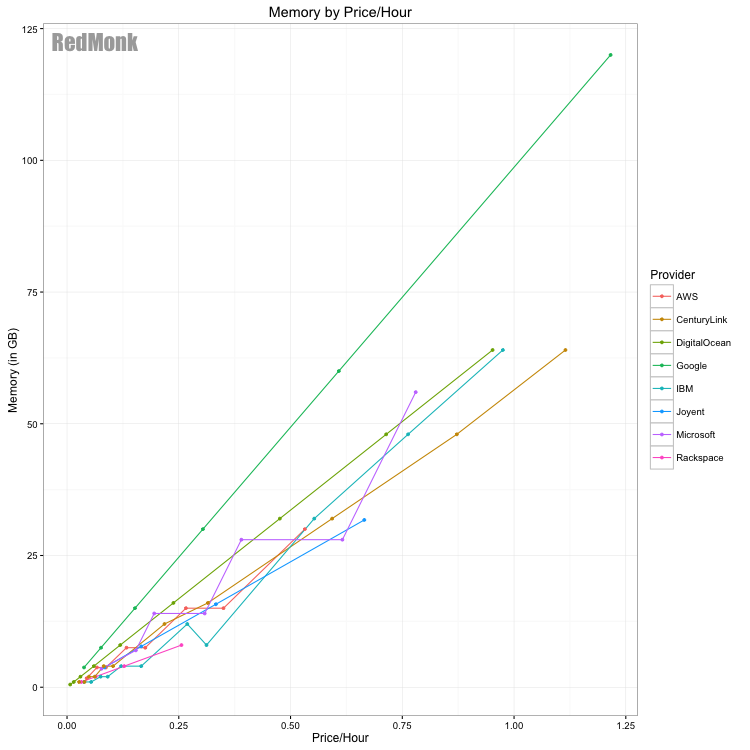It’s been almost two years since our last update of infrastructure as a service pricing. Given the growing size and importance of the cloud market, the competition amongst IaaS providers remains fierce. However, it can be difficult to properly assess how competitive individual providers are with one another because their non-standardized packaging makes it effectively impossible to compare services on an equal footing.
To this end we offer the following deconstruction of IaaS cloud pricing models. This analysis is intended not as a literal expression of cost per service; this is not an attempt to estimate the actual component costs for compute, disk, and memory per provider. Such numbers would be speculative and unreliable, as they would rely on non-public information. Instead, this analysis compares base, retail hourly instance costs against the individual service offerings.
What this attempts to highlight is how providers may be differentiating from each other via their pricing models. In other words, it’s an attempt to answer the question: for a given hourly cost, who’s offering the most compute, disk or memory?
As with previous iterations, a link to the aggregated dataset is provided below, both for fact checking and to enable others to perform their own analyses, expand the scope of surveyed providers or both.
Before we continue, a few notes.
Assumptions
- No special pricing programs (beta, etc)
- No operating system premium. Prices are based on Linux OS.
- No reserved instances. Charts are based on virtual machine price/hour costs.
- No specialized packages (i.e. no high memory, etc)
- Where not otherwise specified, the number of virtual cores is assumed to equal to available compute units.
Objections & Responses
- “This isn’t an apples to apples comparison.“: This is true. The providers do not make that possible.
- “These are list prices. Many customers don’t pay list prices.“: This is also true. Many customers do, however. But in general, take this for what it’s worth as an evaluation of posted list prices.
- “This does not take bandwidth and other costs into account“: Correct, this analysis is server only. No bandwidth or storage costs are included. Those will be examined separately.
- “This survey doesn’t include [provider X]“: The link to the dataset is below. You are encouraged to fork it.
Notes About Vendors
- HPE: HP was previously included in this analysis. HPE has subsequently stopped publishing their Helion price list and the data is no longer available.
- Oracle: Oracle was not previously part of this analysis. We attempted to add them this iteration but were unable to obtain information about their pricing, and as such they remain excluded.
- CenturyLink: CenturyLink is a new addition to the analysis. However, their non-reserved price/hour fluctuates based on the number of hours used. We included their prices based on 720 hours/month as a point of reference. However, given that they don’t have a consistent hourly pricing model, this number should be taken with a considerable grain of salt in terms of its comparative value.
IaaS Pricing
A quick note on how to read the charts: the simplest explanation is that the steeper the slope, the better the pricing from a user perspective. The more quickly cores, disk and memory are added relative to cost, the less a user has to pay for a given asset.
With that, here is the chart depicting the cost of disk space relative to the price per hour.
Amazon stands out due to their divergent pricing; the sawtooth pattern can be understood as two separate product lines. The upper points represent traditional disk-based storage (m1), which Amazon prices extremely aggressively relative to the market. Their m1.xlarge instance offers over 5x more GB of disk space per dollar than the next nearest competitor. The bottom points represents the solid state drive product line (m3), which is more costly and offers the lowest disk space per dollar for all but the m3.2xlarge instance.
Though they are now in the middle of the pack, in the last iteration of this analysis Joyent’s disk space price/hour was competitive to Amazon’s m1 pricing. It will be interesting to watch how Joyent’s June 2016 acquisition by Samsung may impact pricing going forward. Given that Samsung helped Joyent make investments to scale the Manta object storage system before the acquisition, Samsung’s involvement and resources could lead to compelling changes to Joyent’s storage strategy overall.
IBM’s flat line reflects their maximum offer of 100GB of storage in their base pricing. As their overall price increased for instances with higher compute and memory, there was no corresponding increase in disk space.
Google does not list storage in its base pricing and is thus omitted in this chart.
The clustering of storage costs on a per provider basis indicates that for many if not most providers, storage is not a primary focus from a differentiation standpoint.
In keeping with historic trends, the competition between providers is not particularly differentiated in the context of memory per dollar. Google remains the most aggressively priced, offering more memory per dollar spent across each of their instances. In the last update, Google’s n1-standard-32 instance was in beta. As it is now a standard offering, we’ve included it in this iteration of the analysis. This instance in particular increases Google’s competitive offerings in memory and compute.
The other providers are competitively grouped, with varying rank order amongst the providers across their various instances.
Google again is a clear pricing leader, offering the highest amount of compute capacity per dollar spent. Their lead over Amazon’s m1 instances has grown since the last iteration of this analysis, particularly due to the inclusion of the n1-standard-32 instance as noted above.
This trend is particularly notable, as the overall distribution of the compute units/dollar has tightened since the last iteration of this analysis. The decreased difference between the offerings indicates that fewer providers are choosing to differentiate based on pricing of compute units.
IaaS Price History
Besides taking apart the base infrastructure pricing on a component basis, one common area of inquiry is how provider prices have changed over time. It is enormously difficult to capture changes across services on a comparative basis over time, for many of the reasons mentioned above.
That being said, below is a rough depiction of the pricing trends on a provider by provider basis. In addition to the caveats at the top of this piece, it is necessary to note that the below chart attempts to track only services that have been offered from the initial snapshot moving forward so as to be as consistent as possible. HP’s history is included through 2014. CenturyLink as a new addition is included only in 2016.
Larger instances recently introduced are not included, therefore, and other recent additions such as Amazon’s m4 packages and Google’s n1-standard-32 instance are excluded.
Just as importantly, services cannot be reasonably compared to one another here because their available packages and the attached pricing vary widely; some services included more performant, higher cost offerings initially, and others did not. Comparing the average prices of one to another, therefore, is a futile exercise.
The point of the following chart is instead to try and understand price changes on a per provider basis over time. Nothing more, and nothing less.
Implications
In 2014, Steve questioned whether the downward trajectory of prices was sustainable and speculated that we were likely nearing a pricing floor for base IaaS offerings. From this update, the hypothesis appears to have been accurate. In the 2014 update, all providers showed downward momentum in prices except for Microsoft; the results were exactly opposite in this iteration. Microsoft was the only provider in to show downward price movement in their average base packages, with all others showing either static average prices or slightly higher prices than the last update.
Some of the upward price movement is attributed to providers offering more robust base offerings than they were previously, despite our efforts to keep comparisons over time as consistent as possible. That said, it also appears that the trend of ever downward price pressures seems to be alleviating.
One interpretation of this development is that infrastructure is reaching a commodity status. Google in particular is still attempting to differentiate itself via price offerings, but generally speaking this analysis showed increased clustering of many of the providers’ offerings. It will be interesting to observe whether this dynamic continues, particularly as Samsung enters the space via the Joyent acquisition and as Rackspace explores a a private-equity buyout. This does not indicate that competition in the IaaS space will not remain fierce, but it does have some implications about the form we can expect competition to take.
Disclosure: Amazon, CenturyLink, HPE, IBM, Microsoft and Oracle are RedMonk customers. Digital Ocean, Google, Joyent and Rackspace are not.
Data: Here is a link to the dataset used in the above analysis.




Enterprises fighting back, Spring Boot is the best, and other SpringOne Platform takeaways – Richard Seroter's Architecture Musings says:
August 9, 2016 at 4:36 pm
[…] is definitely not a commodity (although pricing has stabilized), but you’re seeing the major three clouds working hard to own the services layer above the raw […]
IaaS Pricing Patterns and Trends – Alt + E S V | RedMonk : Pricing News says:
October 5, 2016 at 1:48 pm
[…] IaaS Pricing Patterns and Trends – Alt + E S V. […]